
The “Leave No Trace Principles for Autumn Camping” article emphasizes the importance of minimizing our environmental footprint while enjoying the outdoors. It covers essential guidelines like planning ahead, staying on trails, packing out trash, respecting wildlife, and being considerate of other visitors. These practices ensure a sustainable and respectful interaction with nature, preserving its beauty for future generations.
Are you planning an autumn camping trip? Discover the essential Leave No Trace Principles to ensure a responsible and environmentally-friendly outdoor experience.
Autumn is a beautiful season to immerse ourselves in nature and enjoy the great outdoors. As responsible campers, it is crucial to be mindful of our impact on the environment and strive to leave no trace. By following the Leave No Trace Principles for autumn camping, we can enjoy the beauty of nature while preserving it for future generations.
Key Takeaways:
- Plan ahead and prepare by understanding regulations, preparing for extreme weather, and scheduling the trip during off-peak times.
- Stick to established trails and campsites to protect fragile vegetation and minimize environmental impact.
- Pack out all trash, bury human waste in catholes, and minimize waste disposal impact.
- Respect cultural and historic structures, leave natural objects untouched, and avoid introducing non-native species.
- Use campfires sparingly or opt for lightweight stoves. Burn wood and coals to ash and use established fire rings.
- Observe wildlife from a distance, avoid altering their behavior, and control pets.
- Be considerate of other visitors by practicing trail etiquette, selecting campsites away from trails and other visitors, and minimizing loud noises.
By embracing the Leave No Trace Principles, we can ensure a sustainable and enjoyable autumn camping experience, safeguarding the beauty of nature for ourselves and future generations.
The Importance of Outdoor Ethics Education
Understanding outdoor ethics and receiving proper education is essential for practicing sustainable outdoor behavior and preserving the wilderness for future generations. By learning about outdoor ethics and incorporating them into our camping practices, we can ensure that our impact on the environment is minimized and that the natural beauty of the outdoors is preserved.
Benefits of Outdoor Ethics Education
When we receive education on outdoor ethics, we gain a deeper understanding of the principles and practices that promote sustainable outdoor behavior. This knowledge allows us to make informed decisions while camping and engage in activities that have minimal impact on the environment. Outdoor ethics education not only benefits the natural world, but also enhances our own experiences in the outdoors.
- We become better stewards of the environment, knowing how to protect and preserve the wilderness.
- We minimize our impact on delicate ecosystems, ensuring that plants, animals, and natural resources are not harmed.
- We enhance the safety and enjoyment of ourselves and others, knowing how to navigate trails responsibly and use outdoor equipment properly.
Promoting Sustainable Outdoor Practices
Through outdoor ethics education, we gain the knowledge and skills to practice sustainable outdoor behaviors. This includes adopting the Leave No Trace Principles, which guide us in minimizing our impact on the environment. By following these principles, we can camp responsibly and leave the natural world as we found it, or even better.
- Plan Ahead and Prepare: This principle helps us understand the regulations, prepare for changing weather conditions, and choose optimal times to visit to avoid overcrowding.
- Travel and Camp on Durable Surfaces: Sticking to established trails and campsites protects fragile vegetation and prevents the creation of new trails.
- Dispose of Waste Properly: Packing out all trash, burying human waste in catholes, and minimizing our waste footprint are essential for maintaining the cleanliness of our surroundings.
- Leave What You Find: Preserving cultural and historical structures, leaving natural objects untouched, and avoiding the introduction of non-native species help maintain the natural integrity of the environment.
- Minimize Campfire Impacts: Using lightweight stoves, adhering to fire regulations, and properly extinguishing fires are crucial for preventing forest damage and reducing air pollution.
- Respect Wildlife: Observing wildlife from a distance and controlling our pets prevent disturbances and harm to the animals.
- Be Considerate of Other Visitors: Practicing trail etiquette, selecting appropriate campsites, and minimizing noise ensure a positive experience for everyone in the outdoors.
By embracing outdoor ethics education and incorporating sustainable outdoor practices into our camping adventures, we can enjoy the beauty of autumn camping while leaving a positive impact on the environment for future generations to enjoy.
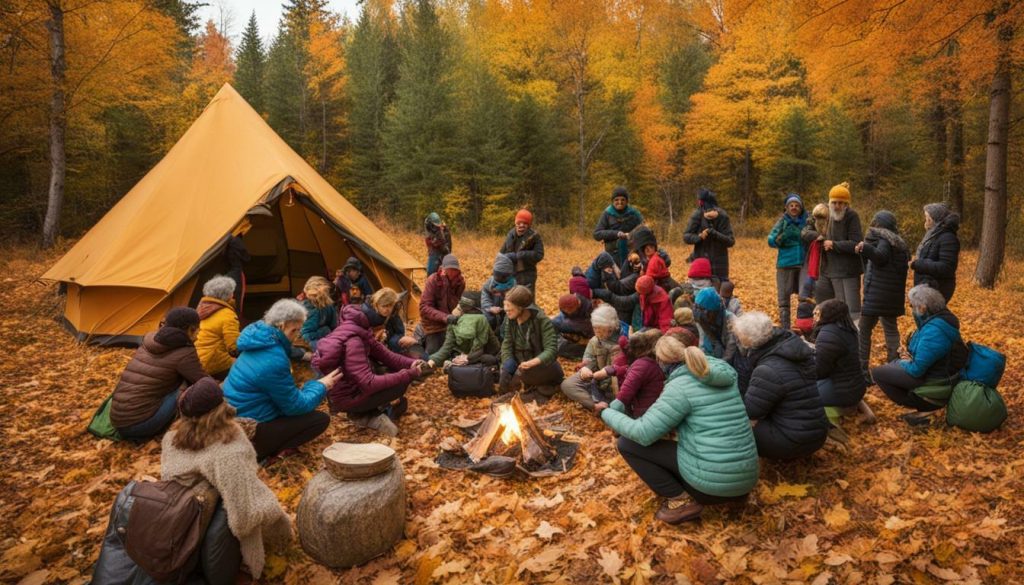
Before embarking on your autumn camping adventure, it’s crucial to plan ahead and prepare to ensure a safe and enjoyable experience while minimizing your impact on the environment. By following the Leave No Trace Principles, you can make informed decisions and be well-prepared for any challenges that may arise during your trip.
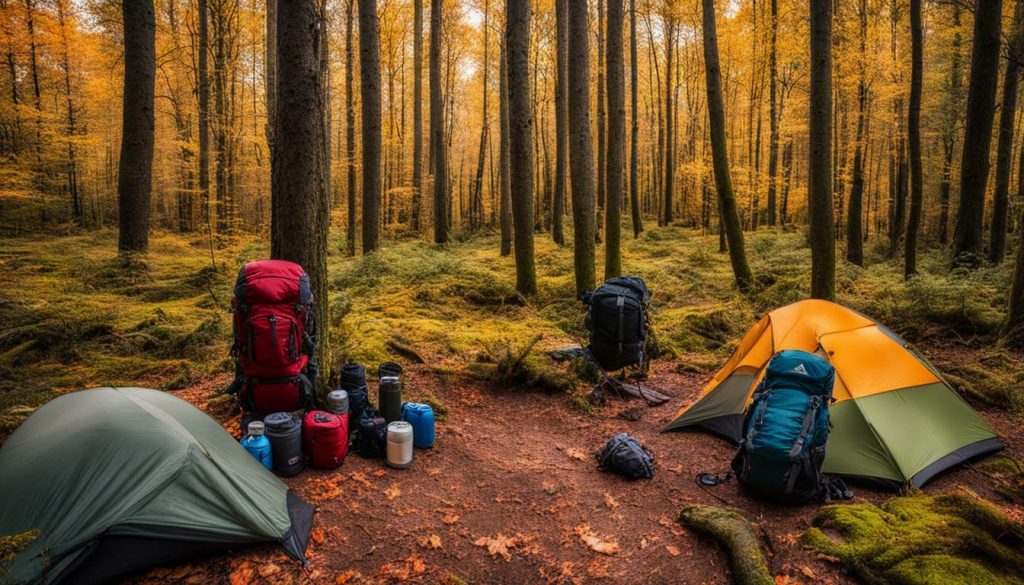
- Familiarize yourself with regulations and special concerns: Research and understand the rules and regulations specific to the area you plan to visit. Take note of any special concerns, such as restrictions on campfires or wildlife management initiatives.
- Prepare for extreme weather: Autumn weather can be unpredictable, with temperature fluctuations and potential storms. Pack appropriate clothing, gear, and equipment to stay comfortable and safe in varying conditions. Be aware of potential hazards like falling leaves, slippery trails, or sudden temperature drops.
- Schedule your trip wisely: To avoid crowded and congested areas, plan your camping trip during off-peak times. This will not only enhance your experience but also reduce your impact on the environment and allow for better social distancing opportunities.
Understanding Extreme Weather
Autumn weather can be beautiful, but it can also change rapidly. It’s essential to be prepared for a range of conditions, from sunny and warm days to chilly, rainy, or even snowy weather. Layering clothing, packing extra insulation, and carrying rain gear will help you stay comfortable and protected.
- Check weather forecasts: Stay updated on the weather forecast for your camping destination and monitor changes before and during your trip. This will enable you to make necessary adjustments and ensure your safety.
- Be aware of daylight hours: As autumn days become shorter, it’s essential to plan your activities accordingly. Allow enough time to set up camp and navigate your surroundings before darkness falls.
- Inform someone of your plans: Before you head out, let a trusted person know about your camping itinerary and expected return date. This will ensure that someone can alert authorities if you encounter any difficulties.
By planning ahead and preparing for your autumn adventure, you can have a fantastic camping experience while minimizing your impact on the environment and staying safe in changing weather conditions.
Travel and Camp Responsibly on Durable Surfaces
To preserve the natural beauty of the outdoors during your autumn camping trip, it’s important to travel and camp responsibly on durable surfaces. By sticking to established trails and campsites, we can protect fragile vegetation and minimize our impact on the environment.
When exploring pristine areas, it’s recommended to disperse use and avoid creating new trails or campsites. This ensures that the natural balance of the ecosystem remains undisturbed, allowing future campers to enjoy the same untouched beauty. By following this principle, we contribute to the preservation of these habitats for generations to come.
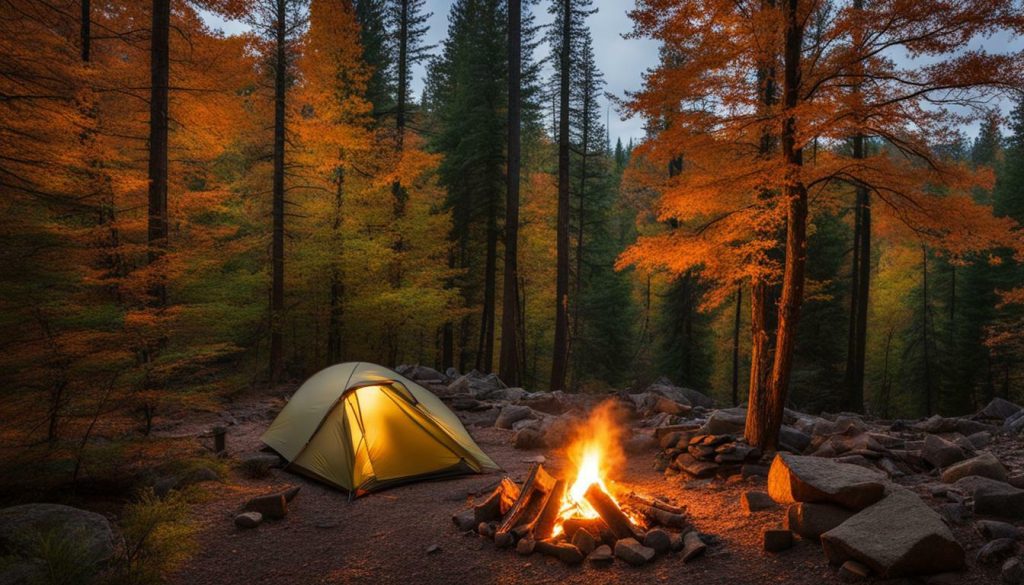
By camping on durable surfaces, we prevent the unnecessary destruction of sensitive ecosystems. It’s important to remember that even small actions, such as stepping on fragile plants or disturbing delicate soil, can have long-lasting effects. So let’s be mindful of our footsteps and leave these natural spaces as we found them.
- Stick to established trails and campsites
- Disperse use in pristine areas
- Avoid creating new trails or campsites
By following these guidelines, we can ensure that our autumn camping adventures have a minimal impact on the environment. Let’s leave behind nothing but footprints and take away nothing but unforgettable memories.
Dispose of Waste Properly to Leave No Trace
Responsible waste disposal is crucial to leave no trace and maintain the pristine condition of the environment during your autumn camping adventure. As outdoor enthusiasts, it is our responsibility to minimize our impact on the natural surroundings and preserve it for future generations. By following proper waste disposal practices, we can ensure that we leave nature untouched and maintain the beauty of our camping destinations.
Pack Out Trash:
- Bring trash bags and pack out all your waste, including food wrappers, cans, and bottles.
- Leave nothing behind that could harm wildlife or disrupt the natural ecosystem.
Bury Human Waste in Catholes:
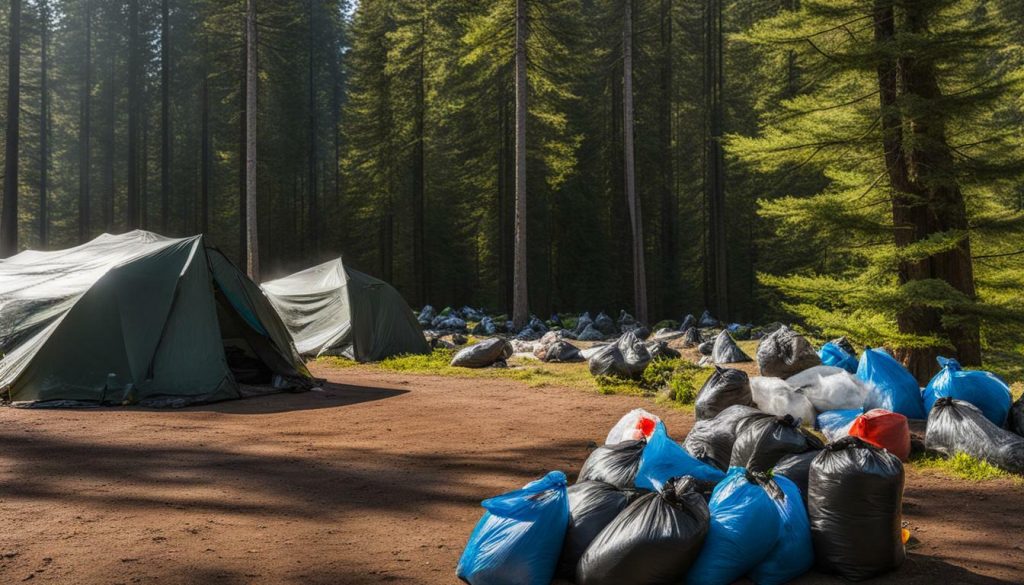
When nature calls, dig a cathole 6 to 8 inches deep and 200 feet away from water sources. This ensures that human waste decomposes properly and minimizes the risk of contamination. Remember to pack a trowel to dig the catholes and cover them up once you’re done. Proper disposal of waste is essential to protect the environment and prevent the spread of diseases.
Leave No Trace:
- Take the principle of “Leave No Trace” to heart and leave your camping area as you found it.
- Dispose of waste responsibly to minimize the impact on the environment and maintain the natural beauty of the landscape for future visitors.
By adopting these waste disposal practices, we can ensure that our autumn camping trips have a minimal impact on the environment. Let’s leave no trace and preserve the pristine condition of our natural surroundings for everyone to enjoy.
Leave What You Find and Preserve Nature
When exploring the outdoors during autumn camping trips, it’s essential to embrace the principle of leaving what you find to protect the natural and cultural treasures of the wilderness. By refraining from touching or altering cultural and historic structures, we can ensure their preservation for future generations. Moreover, by respecting natural objects like rocks and plants and avoiding the introduction of non-native species, we can maintain the ecological balance of the environment.

The Importance of Cultural and Historic Preservation
- Do not touch or remove cultural artifacts or historical objects found in the wilderness. These objects hold significant historical and cultural value.
- Avoid altering or defacing cultural and historic structures such as ruins, rock art, or old buildings.
- Take only photographs and memories to ensure the preservation of these valuable remnants of the past.
Respecting the Natural Environment
- Leave natural objects where you find them. Rocks, shells, and plants play an important role in maintaining the natural balance of the ecosystem.
- Resist the temptation to bring home natural souvenirs as it can disrupt delicate ecological systems.
- Avoid introducing non-native species, such as plants or animals, as they can negatively impact native flora and fauna.
By following these simple guidelines, we can contribute to the ongoing preservation of the natural and cultural wonders that make autumn camping so special.
Minimize Campfire Impacts for Sustainability
Enjoying the warmth of a campfire during your autumn camping trip can be a delightful experience while minimizing the impact on the environment. To achieve this, it’s important to follow the Leave No Trace Principles for campfire impacts. By adhering to these guidelines, we can enjoy the cozy ambiance of a campfire while ensuring the sustainability of our wilderness.
Here are some key tips to minimize campfire impacts:
- Use lightweight stoves: Consider using lightweight stoves for cooking instead of relying solely on campfires. Lightweight stoves are efficient, reliable, and greatly reduce the environmental impact. They also eliminate the need for gathering firewood, which helps in preserving the natural habitat.
- Stick to established fire rings: When campfires are allowed, it’s crucial to use established fire rings whenever possible. These designated areas are specifically designed to contain the fire and minimize the impact on the surrounding environment. By using established fire rings, we can prevent the spread of fire and reduce the risk of damaging vegetation.
- Burn all wood and coals to ash: Before leaving the campsite, ensure that the fire is completely extinguished. Make sure all wood and coals are burned to ash and cool to the touch. This ensures that no live embers are left behind, reducing the risk of wildfires and preserving the wilderness for future campers.
Remember, our goal is to enjoy the beauty of nature while leaving no trace behind. By following these principles and minimizing campfire impacts, we can contribute to the preservation of our cherished natural spaces. Let’s keep the flames of our campfires burning responsibly!
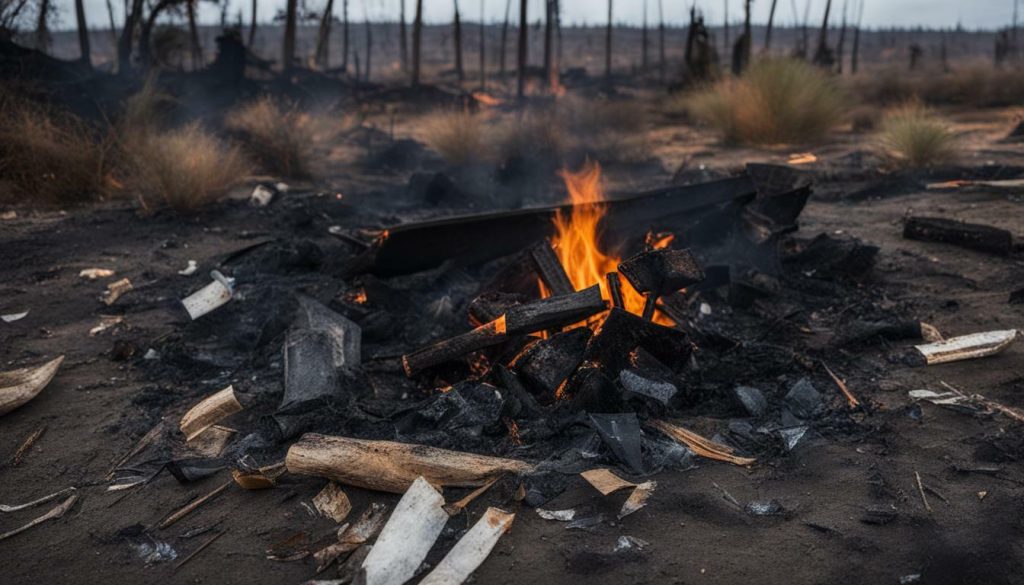
While venturing into the wilderness during your autumn camping trip, it’s crucial to show respect for wildlife and preserve their natural behaviors. As outdoor enthusiasts, we have a responsibility to minimize our impact on their habitat and ensure their well-being. Here are some guidelines to follow:
- Observe Wildlife from a Distance: It’s exciting to encounter wildlife, but it’s important to maintain a safe distance. Getting too close can cause stress to the animals and disrupt their natural behavior. Use binoculars or a telephoto lens to observe them without intruding on their space.
- Avoid Feeding Wildlife: Feeding wildlife can disrupt their natural diet and make them reliant on human food, which can be harmful to their health. Refrain from sharing your snacks or leaving out food attractants that can alter their behavior or lead to conflicts.
- Control Your Pets: If you bring your furry friends along on your camping trip, it’s essential to keep them under control. Pets can chase or disturb wildlife, causing stress and potential harm. Always keep them on a leash and follow designated pet-friendly areas.
- Be Mindful of Nesting Areas: Many animals choose specific areas for nesting and rearing their young. Be mindful of these areas and avoid approaching or disturbing them. This can include bird nests, burrows, and dens. Respecting these spaces ensures the survival and well-being of the wildlife.
By following these guidelines, we can enjoy the beauty of wildlife while contributing to their preservation and conservation. Let’s remember that we are visitors in their habitat, and it is our responsibility to coexist harmoniously with the natural world.

As stewards of the wilderness, it is our duty to preserve wildlife for future generations. By respecting their natural behaviors and habitat, we contribute to the long-term sustainability of our ecosystems. Let’s instill these principles in others by setting a positive example and sharing our knowledge of responsible wildlife observation. Together, we can ensure the beauty and diversity of wildlife persists for years to come.
Be Considerate of Other Visitors for a Positive Experience
Ensuring a positive outdoor experience for yourself and others during your autumn camping trip involves being considerate of other visitors and following proper trail and campsite etiquette. By practicing good manners and respecting fellow campers, you can contribute to a more enjoyable and harmonious environment for everyone. Here are some guidelines to keep in mind:
- Trail Etiquette: When hiking, yield to uphill hikers and give way to faster-moving individuals. Stay on designated paths and avoid cutting switchbacks, as this can cause erosion and damage to the trail.
- Campsite Selection: When choosing a campsite, opt for areas that are already established rather than creating new ones. Respect any posted signs indicating restricted areas or closures.
- Noise Control: Keep voices and noises at a considerate level, especially during quiet hours. Remember that others may be seeking a peaceful outdoor experience.
- Leave No Trace: Follow the Leave No Trace Principles outlined in this guide to minimize your impact on the environment. By practicing responsible camping and conservation, you contribute to the preservation of nature for future visitors.
Remember, we are all here to enjoy the beauty of the outdoors and connect with nature. By being considerate of other visitors, we can create a positive and inclusive environment that allows everyone to fully appreciate the wonders of autumn camping.
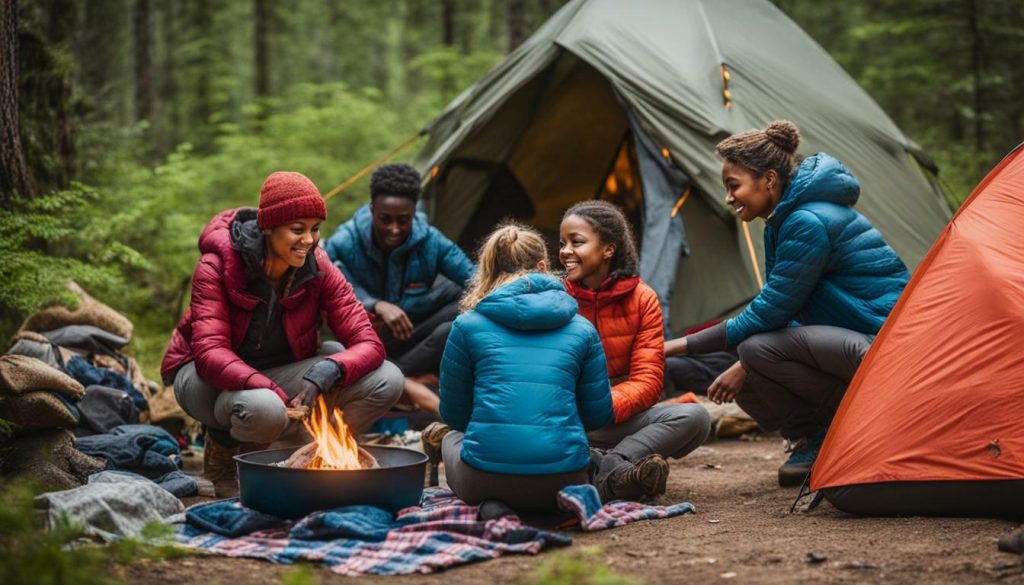
By fully embracing the Leave No Trace Principles, you can enjoy a sustainable autumn camping experience while contributing to the preservation of nature and the sustainability of wilderness areas. These principles serve as guidelines to minimize the impact of our camping activities on the environment, ensuring that future generations can also enjoy the beauty of the outdoors.
When planning your autumn camping trip, remember to plan ahead and prepare. Familiarize yourself with the regulations and special concerns of the area you’ll be visiting. Be prepared for extreme weather conditions and choose your trip dates to avoid peak usage times, allowing for a more peaceful and less crowded experience.
One essential principle is to travel and camp on durable surfaces. Stick to established trails and campsites to protect delicate vegetation. In pristine areas where established sites are not available, disperse use to minimize impact and avoid creating new trails or campsites. This ensures that the natural habitat remains undisturbed.
Another important principle is to dispose of waste properly. Pack out all trash, leftovers, and litter, leaving no trace of your presence. To handle human waste, dig catholes 6 to 8 inches deep and at least 200 feet away from water sources. Proper waste disposal helps preserve the cleanliness and beauty of the wilderness.
Remember to also leave what you find. Cultural and historic structures should be admired but left untouched for future generations to appreciate. Natural objects such as rocks and plants should remain undisturbed, allowing the ecosystem to thrive. Avoid introducing non-native species that can disrupt the delicate balance of the environment.
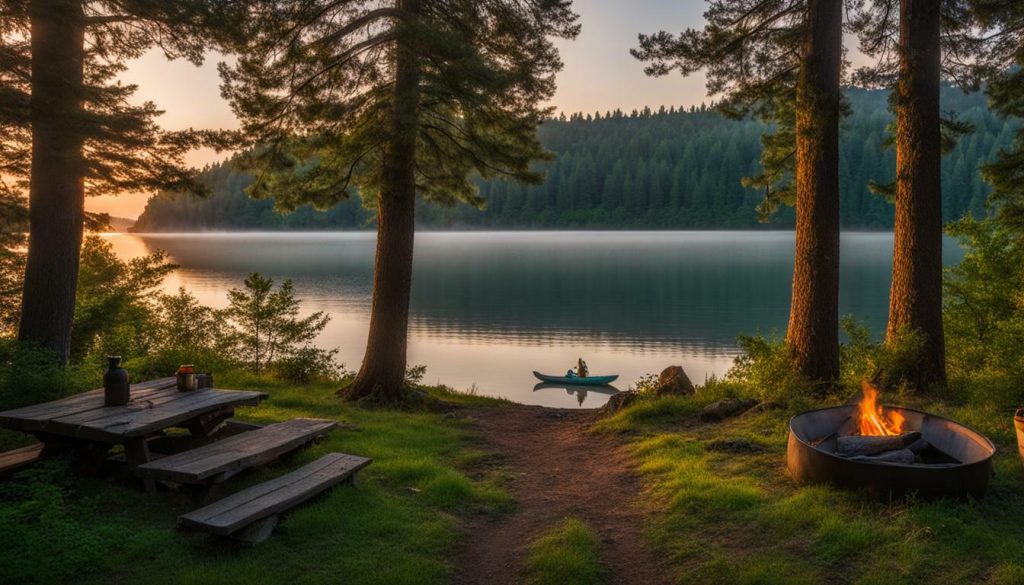
When it comes to campfire impacts, minimize your impact by using campfires sparingly. Opt for lightweight stoves for cooking instead. If campfires are allowed, use established fire rings and make sure to burn all wood and coals to ash. This helps prevent wildfires and ensures that the surrounding environment remains pristine.
Respecting wildlife is crucial, so observe them from a distance. Avoid altering their behavior by keeping a safe distance and refraining from feeding them. If you bring pets, make sure to have control over them or consider leaving them at home to prevent any disturbance to local wildlife.
Finally, be considerate of other visitors. Practice trail etiquette by yielding to other users and selecting campsites away from trails and other visitors. Keep noise levels down for a more serene experience and to respect the tranquility of nature.
By following these Leave No Trace Principles, you can leave a positive impact on the environment while enjoying a responsible and sustainable autumn camping adventure. Let’s strive to preserve nature for future generations and ensure the sustainability of our cherished wilderness areas.
Take Responsible Action and Teach Others
By taking responsible action and sharing your knowledge with others, you become an advocate for environmental stewardship and outdoor ethics education, ensuring a brighter future for our wilderness areas. It is important to lead by example and practice the Leave No Trace Principles during every camping trip. The impact of responsible camping goes beyond our individual experiences; it contributes to the preservation of our natural environment for future generations.
Leading by Example
- Follow all relevant regulations and guidelines for the area you are camping in.
- Show respect for the land and wildlife by adhering to the principles of responsible camping.
- Pack out all trash and dispose of waste properly, minimizing your impact on the environment.
- Leave natural objects untouched and avoid introducing non-native species.
- Be considerate of other visitors by practicing trail etiquette and minimizing noise.
- Have a positive attitude towards outdoor ethics and share your knowledge with fellow campers.
Sharing Knowledge with Others
Educating others about Leave No Trace Principles is essential for promoting sustainable camping practices. Here are some ways you can spread awareness:
- Organize workshops or presentations on outdoor ethics education and responsible camping.
- Engage with local schools, community groups, and outdoor organizations to implement outdoor ethics programs.
- Share your experiences and tips for responsible camping through social media platforms and outdoor forums.
- Encourage others to take the Leave No Trace Online Awareness Course or attend outdoor skills courses.
Remember, the more people we educate and inspire to practice responsible camping, the greater impact we can have on preserving the beauty and integrity of our wilderness areas. Together, we can make a difference.
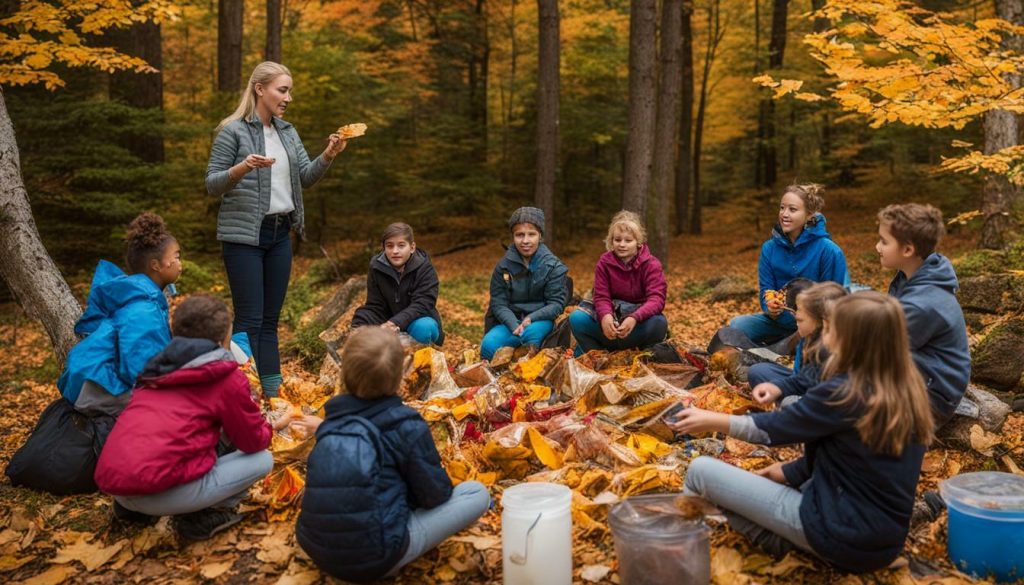
As you embark on your autumn camping adventure, remember to adhere to the Leave No Trace Principles to ensure a responsible and environmentally-friendly experience while enjoying the beauty of nature.
By planning ahead and preparing, you can minimize your impact on the environment by understanding regulations, being prepared for extreme weather, and avoiding peak usage times. Traveling and camping on durable surfaces, such as established trails and campsites, helps protect fragile vegetation and ensures the preservation of pristine areas.
Proper waste disposal is crucial for leaving no trace behind. Pack out all trash and leftovers, bury human waste in catholes, and strive to minimize the environmental impact of camping activities. Leaving what you find, whether it be cultural and historic structures or natural objects, helps preserve the integrity of the wilderness and prevents the introduction of non-native species.
Minimizing campfire impacts and respecting wildlife are essential for a sustainable camping experience. Using lightweight stoves instead of campfires, utilizing established fire rings, and observing wildlife from a distance are all ways to reduce the impact on the environment. Finally, being considerate of other visitors by practicing trail etiquette, selecting campsites away from trails and other visitors, and minimizing loud noises ensures a positive experience for everyone.
By embracing the Leave No Trace Principles, we can enjoy the beauty of autumn camping while preserving nature for future generations. Let us take responsible action and teach others about the importance of responsible camping and nature conservation. Together, we can make a lasting impact and ensure the sustainability of our wilderness.
FAQ
Q: What are the Leave No Trace Principles for autumn camping?
A: The Leave No Trace Principles for autumn camping are guidelines to minimize the impact of camping activities on the environment. They include planning ahead and preparing, traveling and camping on durable surfaces, disposing of waste properly, leaving what you find, minimizing campfire impacts, respecting wildlife, and being considerate of other visitors.
Q: Why are the Leave No Trace Principles important for autumn camping?
A: The Leave No Trace Principles are important for autumn camping to ensure responsible camping practices and nature conservation. By following these principles, campers can minimize their impact on the environment, protect fragile vegetation, preserve cultural and historic structures, and promote sustainable outdoor practices.
Q: What should I do to plan ahead and prepare for my autumn camping trip?
A: To plan ahead and prepare for your autumn camping trip, you should know the regulations and special concerns for the area you’ll be visiting. It’s also important to prepare for extreme weather conditions and schedule your trip to avoid peak usage times.
Q: Why is it important to travel and camp on durable surfaces?
A: Traveling and camping on durable surfaces is important to protect fragile vegetation and minimize environmental impact. It is recommended to stick to established trails and campsites. In pristine areas, it’s best to disperse use and avoid creating new trails or campsites.
Q: How should I dispose of waste properly while autumn camping?
A: To dispose of waste properly, campers should pack out all trash, leftovers, and litter. Human waste should be buried in catholes dug 6 to 8 inches deep and 200 feet away from water sources. This helps to minimize the environmental impact of camping activities.
Q: What does it mean to “leave what you find” during autumn camping?
A: “Leave what you find” means that cultural and historic structures should not be touched or altered. Natural objects like rocks and plants should be left as they are, and non-native species should not be introduced. This helps to preserve the natural and cultural heritage of the area.
Q: How can I minimize campfire impacts during my autumn camping trip?
A: To minimize campfire impacts, it is recommended to use campfires sparingly. Lightweight stoves are a better option for cooking. When fires are allowed, only use established fire rings and burn all wood and coals to ash. This ensures proper campfire practices for sustainability.
Q: How should I respect wildlife during autumn camping?
A: To respect wildlife, it is important to observe them from a distance without altering their behavior. Avoid feeding wildlife and keep pets controlled or leave them at home. This helps to protect the natural habitats and minimize negative impacts on wildlife.
Q: Why is it important to be considerate of other visitors during autumn camping?
A: Being considerate of other visitors is important to ensure a positive outdoor experience for everyone. It’s good trail etiquette to yield to other users, choose campsites away from trails and other visitors, and minimize loud voices and noises that may disturb others.
Q: How can I embrace Leave No Trace Principles for sustainable autumn camping?
A: To embrace Leave No Trace Principles for sustainable autumn camping, it’s important to follow all the principles mentioned earlier. By minimizing your impact on the environment, preserving nature, and practicing responsible camping, you can contribute to wilderness sustainability and enjoy a more sustainable camping experience.
Q: What can I do to take responsible action and teach others about the Leave No Trace Principles?
A: You can take responsible action by applying the Leave No Trace Principles in your camping trips and sharing your knowledge with others. Encourage others to practice responsible camping and promote outdoor ethics education. By being an example and spreading awareness, you can make a lasting impact on preserving the environment.